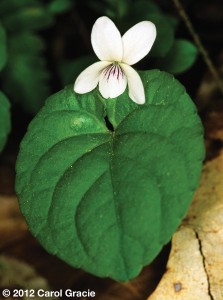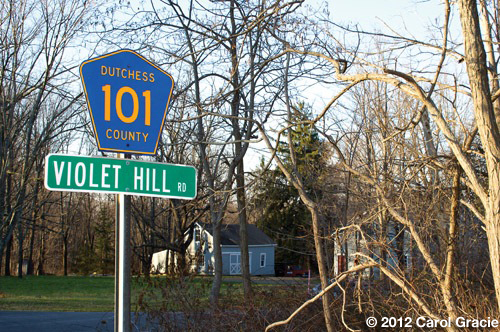Sweet Violets
Posted in Around the Garden on May 29 2013, by Carol Gracie
After spending nearly three decades at the NYBG, and working much of that time in South American rainforests with her husband, Scott A. Mori, Carol Gracie has returned to one of her first botanical interests–local wildflowers. She is the author of Spring Wildflowers of the Northeast: A Natural History and coauthor (with Steve Clemants) of Wildflowers in the Field and Forest: A Field Guide to the Northeastern United States.

Although many of our northeastern violets are lovely to look at, there is only one that is intensely fragrant—the tiny, white-flowered Viola blanda, commonly called sweet white violet. The delicate little flowers are well worth kneeling down and placing your nose right next to them to inhale their sweet scent.
While there, take the time to observe the structure of the flower. Like other members of its genus, the flowers have five petals, the lowest of which is modified into an extended spur to hold the flower’s nectar. Rather than aroma, most of our violet species attract pollinators with their pleasing colors of purple, white, or yellow. To reach the nectar in the deep spur requires a long proboscis such as that of butterflies. By patiently observing a patch of violets, you may be lucky enough to witness one of these pollinators visiting the flowers. In the case of the accompanying photograph, a West Virginia White butterfly visited several species of violets, among them this long-spurred violet, Viola rostrata. The same species of butterfly may also be seen depositing its eggs on nearby toothwort plants (Cardamine spp.), which serve as food plants for its larvae.
Sweet-scented violets have played a notable role in history. The favorite flower of Napoleon and his first wife, the Empress Josephine, was a European violet, Viola odora, which was especially prized for its lovely, sweet scent. Each year Napoleon would present Josephine with a bouquet of sweet violets on the anniversary of their wedding day. Violets, in fact, became a symbol of the Napoleonic reign. Despite Napoleon and Josephine’s great love, when Josephine failed to produce an heir after 13 years of marriage, Napoleon divorced her and married the young Marie Louise, who quickly bore him a son. However years later, when Napoleon died, his locket was found to contain a lock of Josephine’s hair and some pressed violets—a token of his lasting love for his first wife.
Violets were also portrayed in Medieval and Renaissance art as symbols of innocence and purity, and as a representation of these qualities in the Virgin Mary. A well-known example includes what have come to be collectively known as the Unicorn Tapestries. The majority of the many flowers included in the weavings were so accurately depicted by the skilled weavers that they were able to be identified to species by New York Botanical Garden botanists, including Viola odora.
More recently—and more locally—Viola odora and another fragrant, double-flowered European violet, a hybrid Palma violet known as ‘Marie Louise’ (named for Napoleon’s second wife, who was also fond of violets), were important to the economic survival of New York State’s Hudson Valley. In the late 19th and early 20th centuries, the region was experiencing a sharp downturn in its economy. Wealthy estate owners were unable to maintain their extensive greenhouses, and the glass houses were falling into disrepair. It was the inspiration of a British-born entrepreneur, William Saltford, to utilize these greenhouses for the production of violets on a commercial scale. At that time sweet-scented Viola odora and ‘Marie Louise’ violets were popular in Europe, and Saltford saw the potential for them to become favorites here as well. His hunch proved to be accurate, and violets were soon “all the rage” for corsages and nosegays in sophisticated cities such as New York, Boston, Washington, and beyond. Rhinebeck and the surrounding Hudson River towns were soon the self-proclaimed “Violet Capital of the World.”

Due to a fungal disease, and a change in clothing styles in the roaring ’20s, the violet industry began to decline. The Depression years in the 1930s hit hard as flowers were not an essential expense. Hudson Valley resident Eleanor Roosevelt did her best to promote the flowers by frequently wearing violet corsages, but violets were soon supplanted by other more novel flowers. Today, the violet industry is all but forgotten in the Hudson Valley region. Aside from exhibits at the local history museum and a few road signs commemorating the “violet storm,” the only vestige that remains of this once important era is the single row of violets grown in the greenhouses of a descendent of one of the region’s original violet growers.
Learn more about violets and other spring wildflowers in my book, Spring Wildflowers of the Northeast: A Natural History, available for purchase at the Shop in the Garden at The New York Botanical Garden.


what a beautiful & sad story…
as a little girl (feels like almost a century ago), my dad would bring me a bunch of violets sometimes…he influenced my love of flowers…
your photos of the violets and galax and the tiny violet w/butterfly.